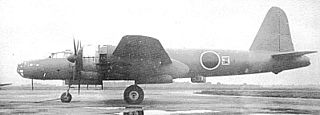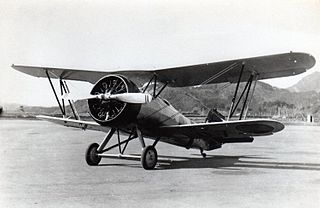
The Mitsubishi A5M, formal Japanese Navy designation Mitsubishi Navy Type 96 Carrier-based Fighter (九六式艦上戦闘機), experimental Navy designation Mitsubishi Navy Experimental 9-Shi Carrier Fighter, company designation Mitsubishi Ka-14, was a WWII-era Japanese carrier-based fighter aircraft. The Type number is from the last two digits of the Japanese imperial year 2596 (1936) when it entered service with the Imperial Navy.

The Mitsubishi A7MReppū was designed as the successor to the Imperial Japanese Navy's A6M Zero, with development beginning in 1942. Performance objectives were to achieve superior speed, climb, diving, and armament over the Zero, as well as better maneuverability – all parameters that were ultimately achieved towards the end of its development in 1945. However, limitations on Japanese industry towards the end of the war prevented the A7M from ever entering mass production or being deployed for active duty, and it never saw active service. Its Allied reporting name was "Sam".

The Mitsubishi F1M is a Japanese reconnaissance floatplane of World War II. It was the last biplane type of the Imperial Japanese Navy, with 944 built between 1936 and 1944. The Navy designation was "Type Zero Observation Seaplane" (零式水上観測機).

The Nakajima G8N Renzan was a four-engined, long-range bomber designed for use by the Imperial Japanese Navy. The Navy designation was "Type 18 land-based attack aircraft" (十八試陸上攻撃機); the Allied code name was Rita.

The Nakajima A4N was a carrier-based fighter used by the Imperial Japanese Navy, and the last biplane designed by Nakajima. The first prototype was completed in 1934, but, due to engine trouble, the aircraft did not see service until 1936. Given the Nakajima internal designation Nakajima YM, but the Japanese Navy designation was Navy Type 95 Carrier Fighter. A total of 221 were built. It saw combat in the Second Sino-Japanese War in the late 1930s.

The Mitsubishi B5M was an Imperial Japanese Navy Air Service (IJNAS) land-based attack aircraft, originally intended for aircraft carrier use. The B5M was also given the long formal designation Navy Type 97 Mk.2 Carrier Attack Bomber and Allied reporting name of Mabel. This aircraft was mistakenly known as the Nakajima Army 97 by the British.

The Nakajima A1N, or Navy Type 3 Carrier Fighter, was a Japanese carrier-based fighter of the late-1920s and early-1930s. It was a licensed copy of the British Gloster Gambet fighter, built by the Nakajima Aircraft Company for the Imperial Japanese Navy. Approximately 150 were built in two versions, the A1N1 and A1N2.

The Mitsubishi B1M was a Japanese torpedo bomber of the 1920s, also known as the Navy Type 13 Carrier-Borne Attack Aircraft. It was designed and built by Mitsubishi and used in combat against China. The aircraft was used by the air services of the Imperial Japanese Navy and Imperial Japanese Army.

The Yokosuka B4Y was a carrier-borne torpedo bomber used by the Imperial Japanese Navy Air Service from 1936 to 1943. The B4Y replaced the Mitsubishi B2M2 and the Yokosuka B3Y, and was the last biplane bomber used operationally by the Imperial Japanese Navy. The Allied reporting name was "Jean". This aircraft was mistakenly identified by the British as the Nakajima Navy G-96.

The Mitsubishi B2M was a Japanese carrier-based torpedo bomber of the 1920s and 1930s. It was built by Mitsubishi to a design by Blackburn Aircraft of Britain and was operated by the Imperial Japanese Navy.

The Nakajima A2N or Navy Type 90 Carrier Fighter was a Japanese carrier-borne fighter of the 1930s. It was a single-engined biplane of mixed construction with a fixed tailwheel undercarriage.

The Mitsubishi Ki-15Army Type 97 Command Reconnaissance aircraft was a Japanese reconnaissance aircraft and a light attack bomber of the Second Sino-Japanese War and Pacific War. It began as a fast civilian mail-plane. It was a single-engine, low-wing, cantilever monoplane with a fixed tailwheel undercarriage; it carried a crew of two. It served with both the Imperial Japanese Army and Navy. During World War II it was code-named "Babs" by the Allies.

The Gloster Sparrowhawk was a single-seat fighter aircraft designed and produced during the early 1920s by the British aircraft manufacturer Gloster.

The Mitsubishi 2MR was a Japanese carrier-based reconnaissance aircraft of the 1920s, also known as the Navy Type 10 Carrier Reconnaissance Aircraft or the C1M in the Navy's short designation scheme. Designed for Mitsubishi by the British aircraft designer Herbert Smith, the 2MR was used by the Imperial Japanese Navy through the 1920s and 1930s.

The Mitsubishi K3M was a trainer built by Mitsubishi which was used by the Imperial Japanese Navy in an extremely wide variety of roles, including light transport, liaison aircraft, utility aircraft, and occasionally light bomber. Its Allied reporting name was Pine.

The Mitsubishi 1MT was a Japanese single-seat triplane torpedo bomber built by Mitsubishi for the Imperial Japanese Navy Air Service. Designed by the former Sopwith designer Herbert Smith, it was intended for use aboard the Japanese aircraft carrier Hōshō.

The Mitsubishi 2MB1 was a light bomber produced in Japan in the mid-1920s to equip the Imperial Japanese Army.
The Kawanishi K-11 was a 1920s Japanese single-seat carrier fighter designed and built by the Kawanishi Aircraft Company to meet an Imperial Japanese Navy requirement. The type did not enter service, and only two prototypes were built.

The Mitsubishi 1MF9 or Mitsubishi Experimental Taka-type Carrier Fighter was a prototype Japanese fighter aircraft of the 1920s. It was a single-engined, single-seat biplane intended to operate from the Imperial Japanese Navy's aircraft carriers, but only two were built, with the type being rejected by the Navy.
The Mitsubishi J4M Senden or Navy Experimental 17-Shi Otsu B Type Interceptor Fighter Senden, Allied reporting name Luke, was a Japanese World War II fighter aircraft proposed by Mitsubishi Heavy Industries for use by the Imperial Japanese Navy. The J4M project did not proceed beyond the design stage.


















